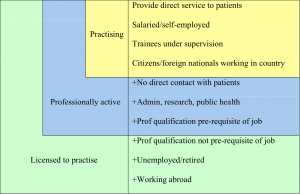Methodological Notes – Health Workforce Module
Updated: January 2019
Concepts and Definitions
The health workforce is made up of many different types of workers. The World Health Organization’s International Classification of Health Workers recognizes five broad categories: (1) health professionals, (2) health associate professionals, (3) personal care workers in health services, (4) health management and support personnel, and (5) other health service providers. http://www.who.int/hrh/statistics/Health_workers_classification.pdf. Health professionals vary substantially in their training, licensure and registration requirements, and how statistics on employment are collected.
The names of selected health professionals in the official languages of circumpolar countries are shown below:
| English/French | physician/médecin | dentist/dentiste | nurse/infirmière | public health nurse/infirmière de santé publique |
midwife/sage-femme |
|---|---|---|---|---|---|
| Danish | læge | tandlæge | sygeplejerske | sundhedsplejerske | jordemoder |
| Finnish | lääkäri | hammaslääkäri | sairaanhoitaja | terveydenhoitaja | kätilö |
| Icelandic | læknir | tannlæknir | hjúkrunarfræðingur | ljósmóðir | |
| Norwegian | lege | tannlege | sykepleier | helsesøster | jordmor |
| Swedish | läkare | tandläkare | sjuksköterska | distriktssköterska | barnmorska |
| Russian | vrach | stomatolog | medicinskaya sestra | akusherka |
OECD makes the distinction among the categories of “practising”, “professionally active”, and “licensed to practise”. This is summarized in the figure below.

Some countries do not distinguish “practising” and “professionally active” There are usually two ways to count workers, by a head count or the number of full-time equivalent (FTE). It is difficult to apply the FTE concept to self-employed professionals who do not have regular hours of work. The data presented in CircHOB are based on head counts. Some countries provide data from employment records, some conduct surveys, and some include only public sector employees.
Among the many types of health professionals, CircHOB selects physicians, dentists and nurses for monitoring. Physicians and dentists include interns/residents, defined as trainees who have graduated but are undergoing further clinical training under supervision. Both generalists and specialists are included. The United States is unique in including doctors of osteopathy (DO) as physicians. DOs are now indistinguishable in training and scope of practice from doctors of medicine (MDs), whereas outside the U.S. osteopathy tends to treat only musculoskeletal disorders. Dentists (or stomatologists) are not included under physicians, although in some countries (such as Russia) they are considered medical specialists.
OECD includes under “professional nurses” clinical nurses, district nurses, nurse-anesthetists, nurse-educators, nurse-practitioners, public health nurses, and specialist nurses. Excluded are midwives (unless they are also registered as nurses and working as nurses), nursing aides, associate professional nurses, practical and vocational nurses.
The measure used to compare the availability or supply of health professionals is density, expressed as the number of professionals per 100000 people in the population. Where possible, it is data on practicing professionals that are presented. Some countries do not distinguish between the “practising” and “professionally active” categories.
